|
|
ADDRESS TO THE MEMBERS OF THE KARNATAKA LEGISLATIVE ASSEMBLY, BANGALORE
20-11-2005 : Bangalore
Missions for Karnataka's Prosperity
I am delighted to be in Bangalore and to have the opportunity to address the Hon'ble Members of the Legislative Assembly and Legislative Council of Karnataka. You are all members of a great institution that gives vision to the state and evolves the legal framework, the policies and programmes of the State. Your mission is to make the aspirations and dreams of people of this state become a reality.
I am very happy to be with you in your celebrations of Suvarna Karnataka and my greetings to the people of Karnataka on behalf of the nation and my own personal behalf.
Karnataka and me
Whenever I visit Karnataka, I always recall the contribution of Karnataka in shaping my career. On the soils of Karnataka, more so at Bangalore, I started my journey into the world of Science and Technology. In 1958, I joined the Aeronautical Development Establishment (ADE) as a Senior Scientific Assistant. ADE was located in High Grounds in those days, where the planetarium is presently located. This is the city, which fostered my scientific career and empowered me without bothering about my age. This gave me a lesson in my life that I must respect what is said rather than who said it. The Hovercraft, that was the first exhibition of what could be done in India in the world of flying machines, gave me a chance to pilot Sri S. Nijalingappa, the then Chief Minister of Karnataka from High Grounds to Cubbon Park, barely few inches above the ground. This is my first theatre of action, which gave me the confidence that "It can be done" in India by Indians.
Bangalore is also the place where I met my teacher Prof. Satish Dhawan. He not only taught me the nuances of aerodynamics which I effectively used in the design of contra rotating propeller in the hovercraft, exposed me to the art of design, development and project management. He was a doyen of Indian aerospace, became the Director of Indian Institute of Science and subsequently the Chairman of ISRO. My teacher made Bangalore his home and spent all his life in Bangalore. Under his guidance, I was appointed as the Project Director of the first indigenous Satellite Launch Vehicle. This started the saga of putting Indian satellites in orbits using our own rocket systems.
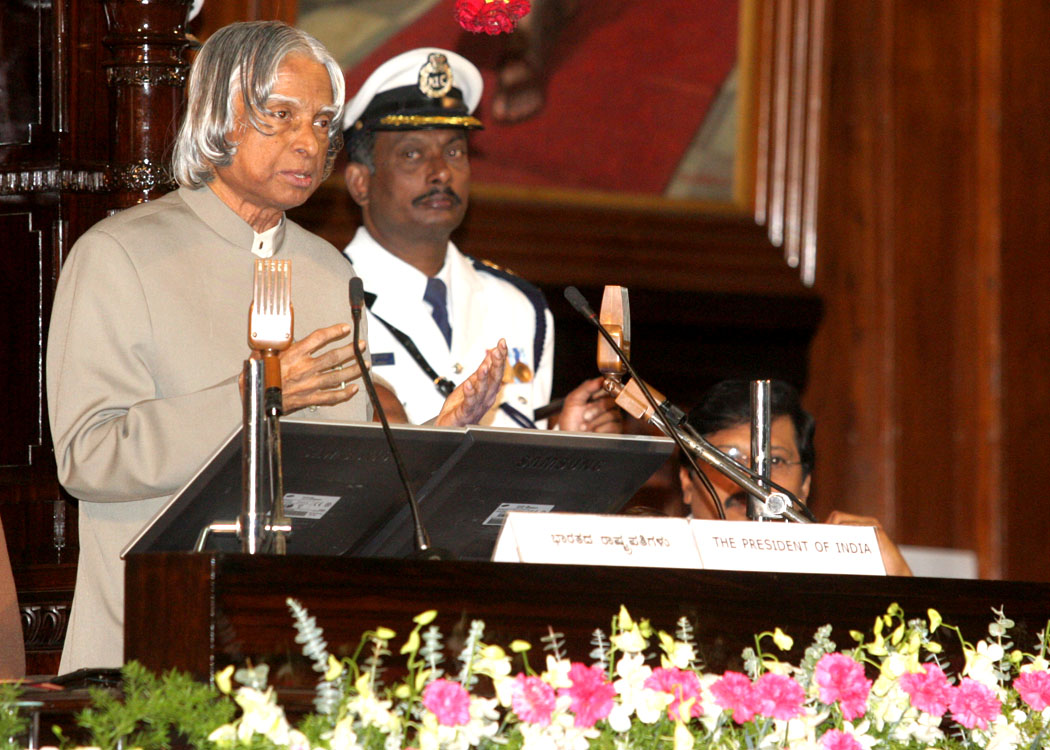
For any rocket engineer in India, Karnataka had always been a source of inspiration. The heritage and past glory that can be sung in Karnataka would make any nation proud. In the history of rocketry, the first war rocket was designed, developed and operationalised in a war in Sri Rangapatna (1794). It was a thrilling experience for me to have seen the class of rockets that Tippu deployed against the British in the first Sri Rangapatna war. This, I saw at the Wooldridge Artillery museum near London.
With this past, Karnataka would always stand as a symbol in the hearts of people as a state, which can create great visions and realize them overcoming any hurdles that may come in their way. Karnataka will always be a role model and would come out always with flying colors.
Revolutions are not new to Karnataka. Nearly 100 years back Karnataka started the revolution in Higher Education and Research in the India ruled by the British, by giving home to the Indian Institute of Science. In the early fifties, Bangalore started the Aeronautics revolution from its HAL. In the sixties, DRDO created centres that later became generators of technologies, Bangalore was the leader. From the headquarters of ISRO and its Satellite Center, Bangalore was the hub of space research in India. The electronics revolution started with the Bharat Electronics and ITI located in Bangalore. The role of Karnataka in general and Bangalore in particular in more recent revolutions of IT, BT and Pharma is legendary. In a world where technological revolutions take place at a rapid pace, states like Karnataka will continue to play a leading role and retain its status as the science capital of the country. Of course it is a tremendous responsibility that solely rests on the shoulders of this august body of legislators.
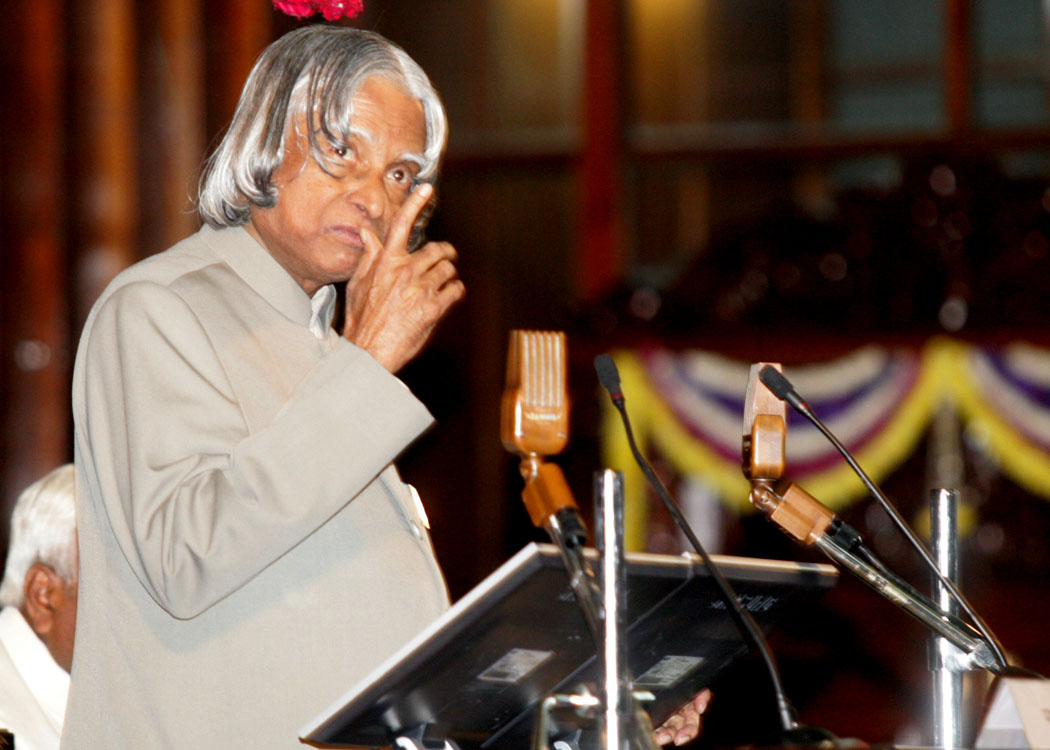

Cultural Heritage
Karnataka is a state where intellectual alertness coexists with a very rich cultural heritage. Let me recall with great happiness and joy that Karnataka's rich and vibrant culture, reflected in its varied art forms. Elaborate dance-drama performance is unique to Karnataka. It is a rare combination of dance, music, songs, scholarly dialogues and colourful costumes. Your ancient art of leather puppetry draws heavily on mythology, especially stories from the Ramayana and the Mahabharata. The Mysore style of Bharatanatyam and Yakshaganam - the oldest and the most popular form of classical dance in India is widely performed with other mainstream classical dances that include Kuchipudi and Kathak. Every time I think of Carnatic music, Purandara Dasa's composition "Bhagyada Lakshmi baramma...." in Madhyamavati raga rings in my ears; It is indeed heavenly.
Karnataka is famous for its aesthetic craftsmanship in sandalwood and rosewood. Karnataka's contribution go beyond satisfying the mind and the ears. It also extends to culinary delights such as Mysore Rasam and Mysore Pahu, Bisi Bela Baath, obbiddu, Mysore bonda and Mudur Vada. I am sure tonight dinner we will have many of them. God bless you.
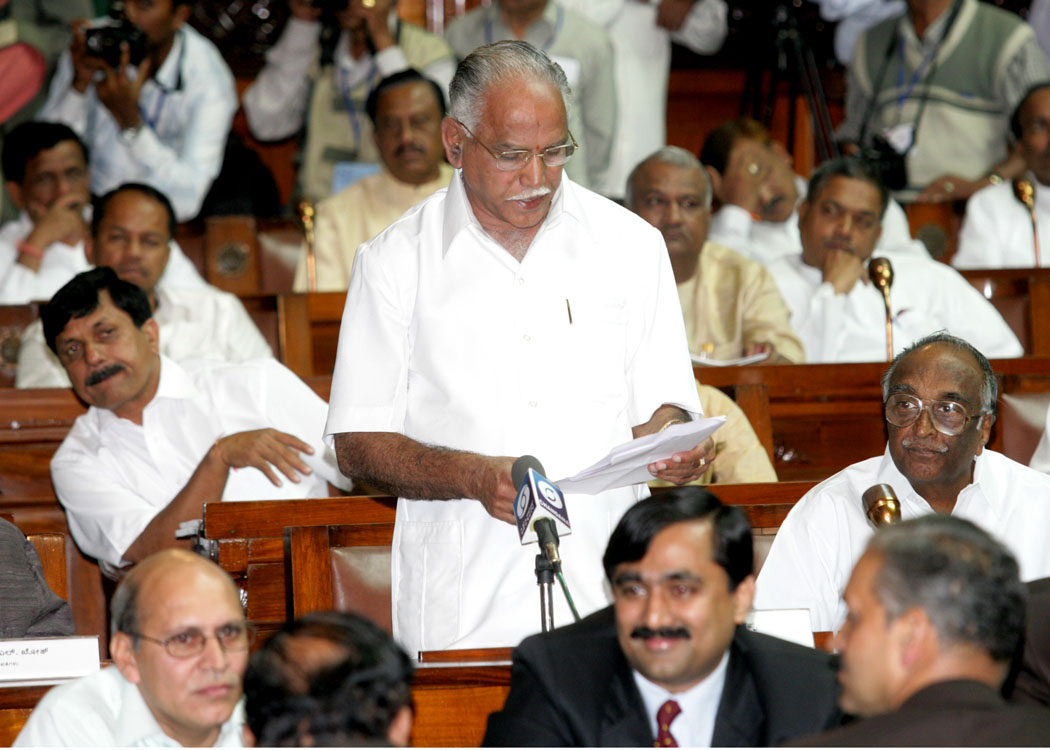
On November 1, 1956 the state of Karnataka was born. Today when we celebrate the Suvarna Karnataka, it is to pay our tribute to the Legislative Assembly and the Council of Karnataka as well as the people of Karnataka. The legislators have wisely guided the State's growth since its formation in the year 1956. In the face of many challenges, various governments have placed Karnataka on a positive-growth track. I would like to share a few thoughts with the Hon'ble Members of Karnataka Legislative Assembly and Council on: "Missions for Karnataka's prosperity".
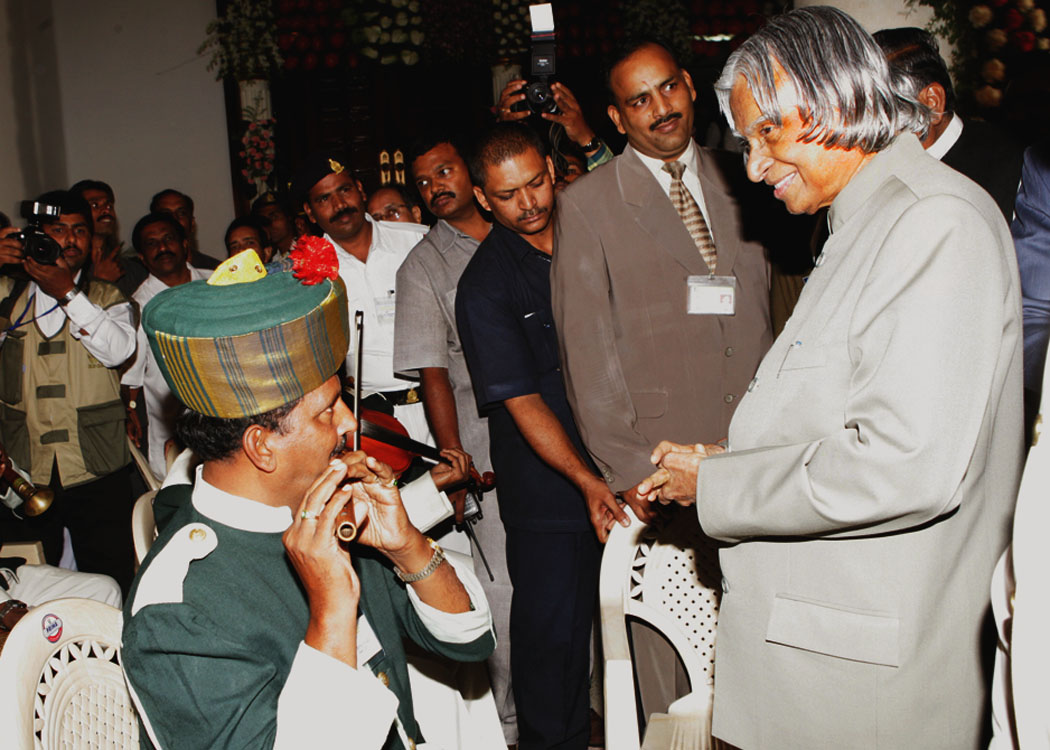

Our National Mission - Challenges
Our nation is going through a major challenge of uplifting of 260 million people who are below the poverty line. They need habitat, they need food, they need health care, and they need education and employment finally resulting in a good life. Our GDP is growing at more than 7% per annum. Whereas, the economists suggest that to uplift the people from below poverty line, our economy has to grow at the rate of an additional 3% per annum consistently, for over a decade.
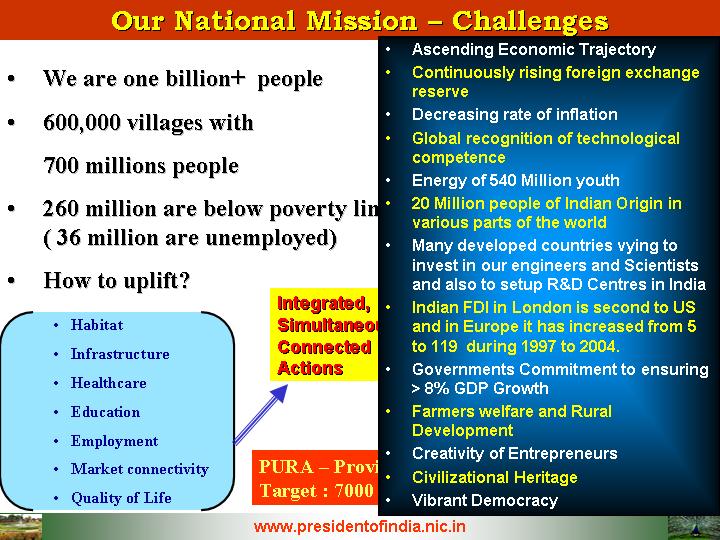

Integrated Action for Development
Our mission of transforming India into a Developed Nation, is to meet the needs of one billion people. We have identified five areas where India has core competencies for integrated action: (1) Agriculture and food processing (2) Reliable and Quality Electric power, Surface transport and Infrastructure for all parts of the country. (3) Education and Healthcare (4) Information and Communication Technology (5) Self reliance in Strategic sectors. These five areas are closely inter-related and when effectively addressed, would lead to food, economic, energy and national security and lead to sustainable prosperity.
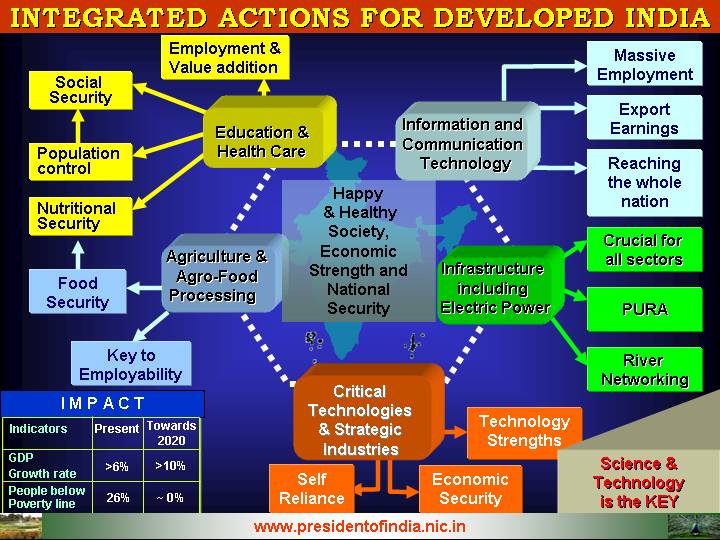

Engines for Growth
Emphasis should be on full utilization of natural and human resources of the region to meet the demands of the modern society. We should also remember that about 50% of our population is young people, with aspirations for a better life. Value addition to Agriculture, Manufacturing and Service sectors of the economy, building on the regions' core competencies and technologies, will lead to high incomes, employment potential and growth rate. The engines for growth will be launching of the five national missions viz. water, energy, education and skills, infrastructure and employment generation. Developed states result in developed India.
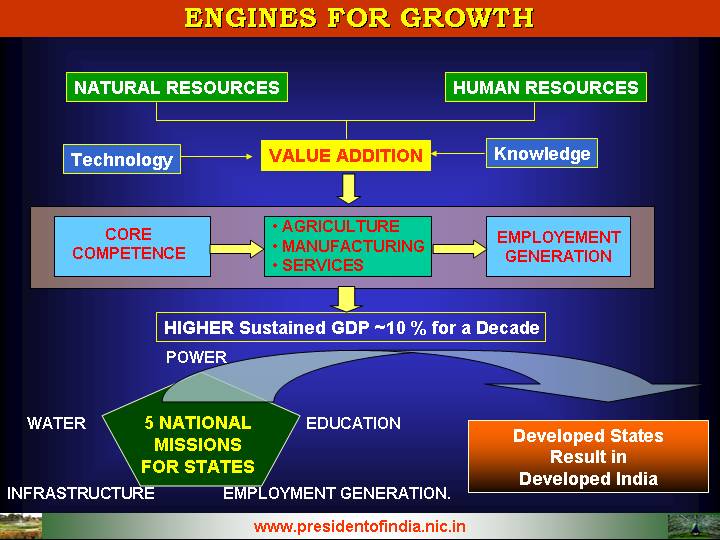
Now, I would like to discuss about the core competence of Karnataka.
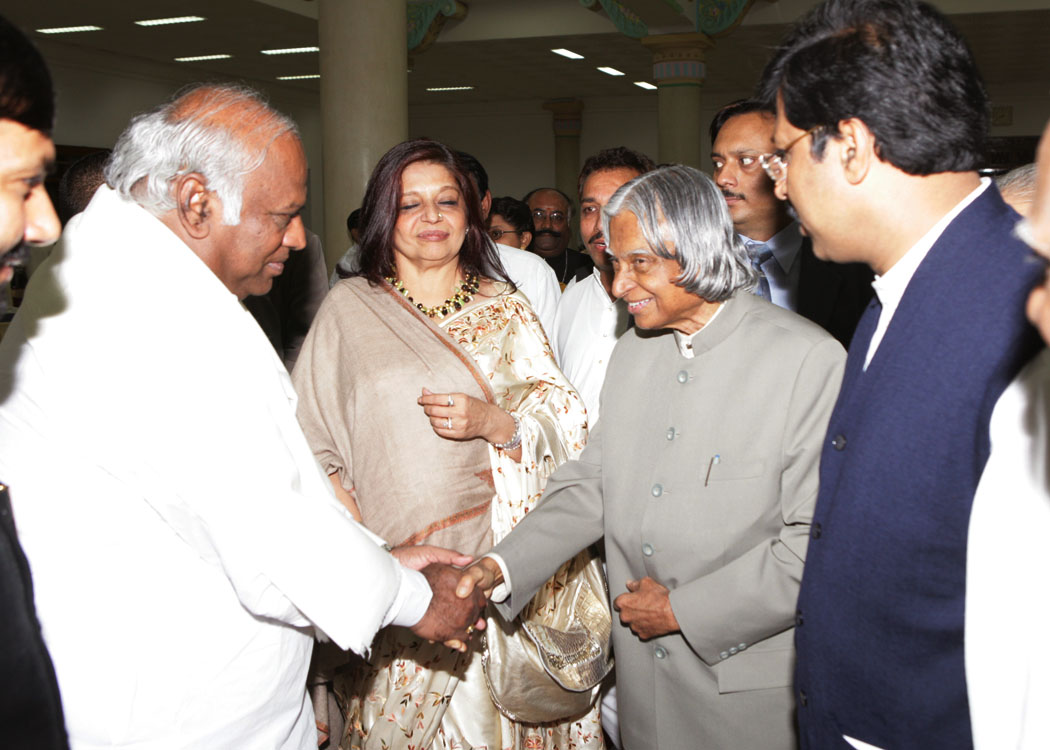

Core competence of Karnataka
Karnataka is bordered by the Arabian Sea to the west, Goa to the northwest, Maharashtra to the north, Andhra Pradesh to the east, Tamil Nadu to the east and southeast, and Kerala to the southwest. The western and eastern mountain ranges of South India converge.
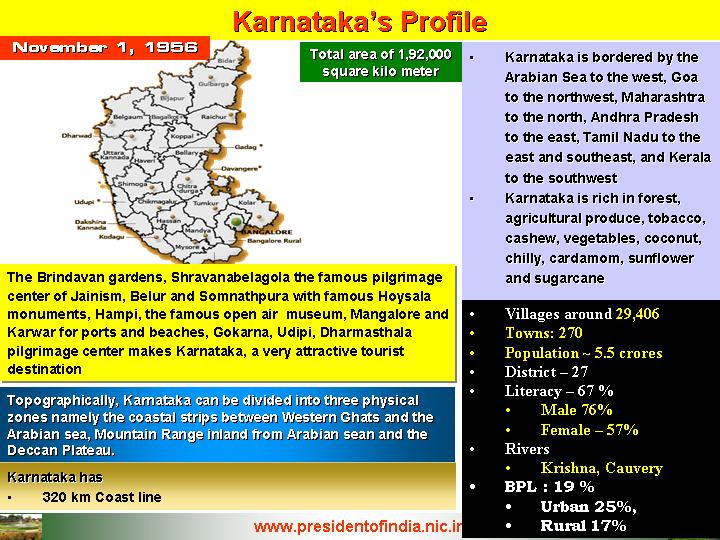
The state has a total area of 1,92,000 square kilo meters. Topographically, Karnataka can be divided into three physical zones namely the coastal zone between Western Ghats and the Arabian sea, Mountain Range and the Deccan Plateau. There are seven river systems in Karnataka. Of the seven rivers, the Krishna and the Cauvery provide the maximum drainage area.
Karnataka is rich in forest, agricultural produce, tobacco, cashew, vegetables, coconut, chilly, cardamom, sunflower and sugarcane. The Brindavan gardens, Shravanabelagola the famous pilgrimage center of Jainism, Gokarna, Udipi, Dharmasthala pilgrimage centers, Belur and Halebid, Somnathpura with famous Hoysala monuments, Hampi, the famous open air museum, Mangalore and Karwar for ports and beaches, make Karnataka, a very attractive tourist destination.
The literacy in Karnataka is over 67%. Karnataka is also one of the early states to have successfully privatized engineering, medical and management education and today boasts of one of the largest producers of professional graduates. Capacity building and providing manpower that is, highly skilled, technologically trained and cosmopolitan in upbringing have become hallmarks of Karnataka.
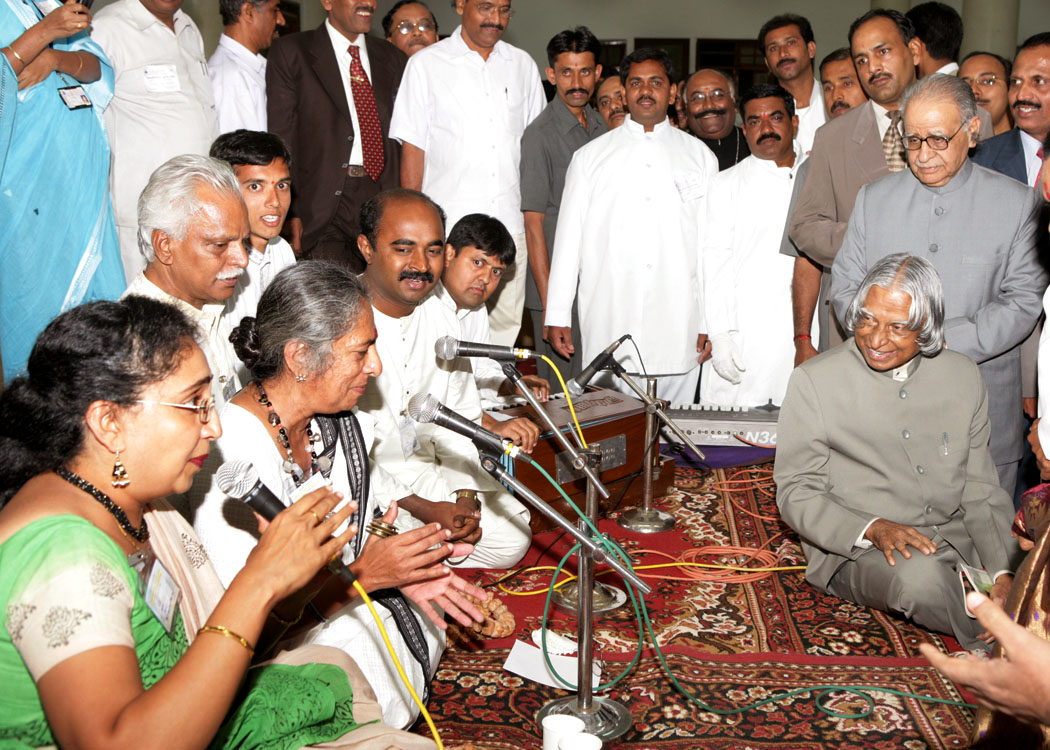

Developed States means Developed India
With all these favourable factors, what can be the missions for Karnataka? Since the number of people living below poverty line in Karnataka is about 19%, the first mission is to elevate all of them and bring smiles in their faces. This can be done by having a focused development leading to higher per capita income and better quality of life. Your state can definitely transform into an economically developed model state. At this stage, let me share with you the Development Radar brought out by the Planning Commission.
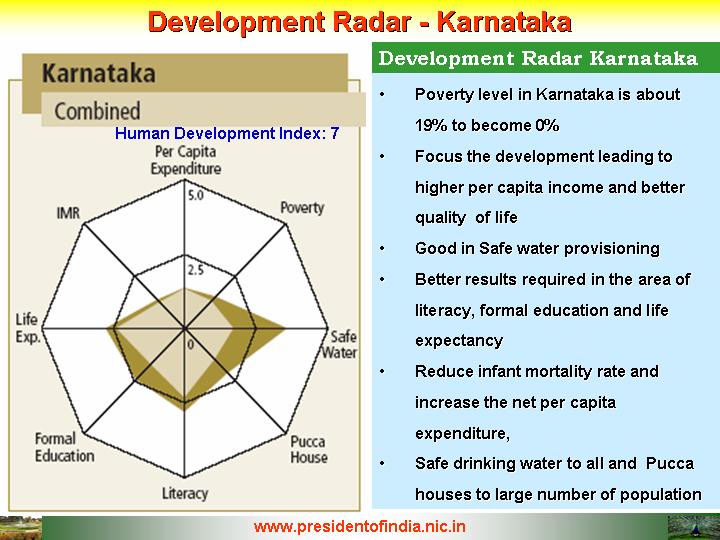
The boundary of octagon projected in the development radar indicates the maximum achievements of various indicators of development. The smaller octagon represents the national average. While we appreciate you for your achievements in safe water provisioning, you can achieve better results in the area of literacy, formal education and life expectancy. The Hon'ble Members need to realize that Karnataka has got the potential to reduce infant mortality rates substantially, increase the net per-capita expenditure in addition to reducing the poverty level and provision of pucca houses to all the members of the State. In essence Karnataka should aim at improving the living standards and quality of life for all people in the State particularly the people living in the rural areas as in the developed world.

Focus Karnataka
I am happy to learn that the Government of Karnataka has already chalked out a road map for its full fledged development. My presentation to this Legislative Assembly will focus on how the percapita income of Karnataka can be increased from the existing Rs. 26,000 (at 2004-2005) to Rs. 75,000 by 2009 and also to create investment friendly climate leading to employment avenues for the two million unemployed or underemployed persons of the state. Karnataka should aim at realizing the goal of 100% literacy by the year 2012.
In Karnataka, with its Human Development Index ranking being seven, it is possible to increase the revenue generation of the state and earning capacity of the citizens through certain development missions, which I will be discussing. We need to go for intensive agro food processing, enhancing the horticultural produce, jatropha cultivation and its conversion into bio-fuel, enhancing the tourism potential of the state in addition to maintaining and improving the success achieved in information and communication technology and aeronautic sector.

Missions for Karnataka
Let us study what are the missions which Karnataka can undertake based on the core competence of the state. The following are some of the important missions for Karnataka's prosperity:-
1. Textiles
2. Energy
a. Bio-fuel mission
b. Power through Municipal Waste
3. Horticulture
4. Agro-processing
5. Water Management
6. Tourism
7. Preparing Paramedics and technicians with
Quality training
8. Creation of industries for Knowledge products
9. GRID Connectivities for sustainable growth
10. Establishment of PURA for Rural prosperity
11. Development facilitators
Let me now discuss each of the missions:

Mission # 1: Textiles
Karnataka is famous for silk. The climate of Karnataka is also suitable for growing cotton. Some of the areas of Karnataka can diversify into production of cotton based on newer experiences which are available from Punjab where the average production of cotton has gone upto nearly 900 kg per acre. I would like to link cotton production to garment and apparel export business, which is a low investment and large volume employment generator using the innovative ideas of fashion technology. Two centers are well known Tirupur in Tamilnadu and Ludhiana in Punjab. India is presently, exporting six billion dollars worth of garments, whereas with the WTO regime in place, we should aim to enhance the production and export of apparel and garments to over 18 to 20 billion dollars within the next three years. This will need establishment of garment and apparel industries in different parts of the country. Karnataka Government with intense collaboration between NIFT, Textile Research Associations, textile industrialists can work out a mission mode programme for exporting One billion dollars of garment within the next three years. This will be a large-scale generator of employment for the Karnataka youth particularly in the rural areas. The number of direct jobs which can be generated through this mission will be four lakhs and another four lakh indirect jobs in allied sector primarily in the cultivation of cotton. Concerted effort is needed in application of new fibres including varieties of cotton, newer fashions, technology generation, and transfer of technology, production and aggressive marketing strategy.
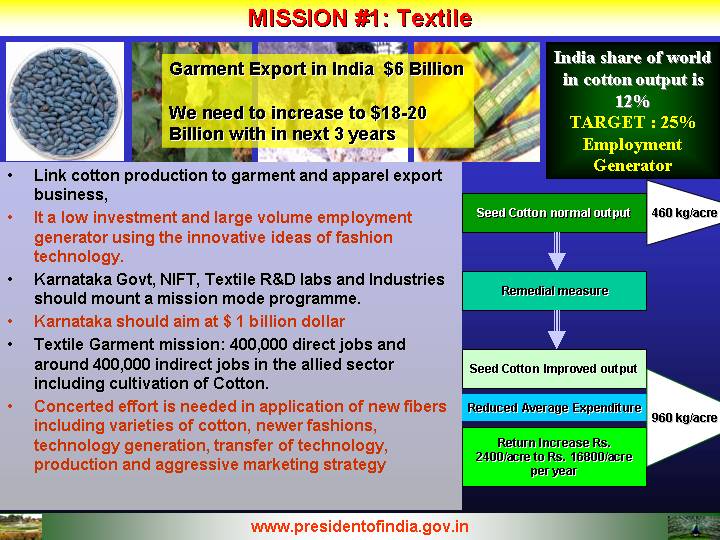

Mission #2: Energy
Bio-fuel mission: Karnataka has 71 lakh hectares of waste land. Certain multi-purpose bio-fuel plants can grow well in this land with very minimum input. Once cultivated, the crop has fifty years of life. Fruiting can take place in these plants in two years.
Bio-fuel plants can be grown in at least 50% of the waste land namely 35 lakh hectares. This plantation can result in producing 35 lakh tons of bio-fuel in a year. The Central Government has approved mixing of 10% bio-fuel with diesel for cars, whereas there are experiences in case of trucks and tractors, mini vans with higher percentages of bio-fuel in India.
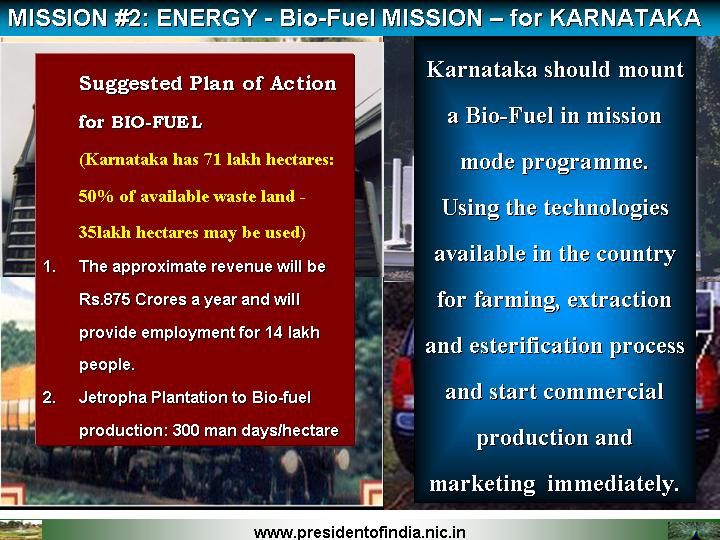
The approximate revenue will be Rs.875 Crores a year and will provide employment for 14 lakh people. In addition it will provide seasonal employment of 300 man days in a year per hectare to cover the plantation to bio-fuel production. It will reduce the foreign exchange outflow paid for importing crude oil, the cost of which is continuously rising in the international market. This Bio-fuel is carbon neutral. The oil can also be used for soap and in candle industries. De-oiled cake is a raw material for composting and the plantation is also good for honey production. This will be the additional benefit from the plantation of Jatropha, a popular bio-fuel plant being planted in states like Madhya Pradesh, Chattisgarh, Tamil Nadu, Andhra Pradesh, and Uttaranchal besides Ministry of Railways. Karnataka should mount a mission mode programme, absorb the best of the technologies available in the country and start commercial production immediately.
Converting waste into Energy: Power generation Sector of the energy economy, need to fully use the technologies now available for generating power from municipal waste. Today, two plants are operational in India, each plant generating 6.5 MW of electric power in Andhra Pradesh. Bangalore and all the tier-2 cities in Karnataka can emulate this model and create plants which are run on municipal waste. Bangalore city produces over 2500 tons of waste per day. Using this waste Bangalore city can have seven power plants with a generating capacity of 6.5 MW each. Alternately, Bangalore can also think in terms of having two 20 MW plants. This will not only ease the power situation in Bangalore to a certain extent, but also assist in the management of waste without being a load on the urban land. Similar plants can also be erected in all the tier-2 cities of the state.
The Government of Karnataka can tie-up with CII, TIFAC and private industries who have successfully established the power plants and which are in operation.
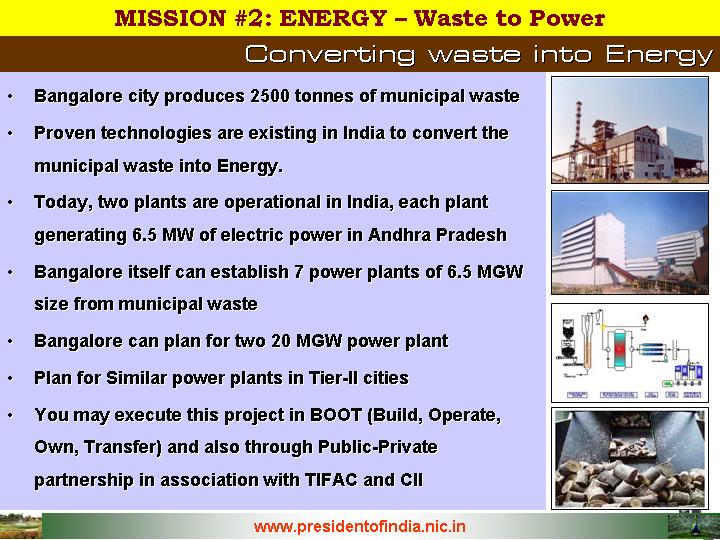

Mission #3: Horticulture
Karnataka is a state with potential for cultivation of Cash crops like grapes, coconut, tomato, mango, banana, spices, floriculture and medicinal plants. Emphasis is needed in the development of irrigation infrastructure and distribution network. Also, there is a need for increasing the level of mechanization to reduce the cost of cultivation in horticultural estates. The displaced labour should be moved to agro processing and other services sectors. Focus should be on watershed development approach. Research is required for developing high-yield low gestation period crops which will be suitable for use by the food processing industry. For example, tomato grown in Karnataka has a large amount of water content with low pulp content. There is a need to work on tomato variety which will be more pulp and be useful for conversion into ketchup and other processable tomato products. These activities have to be taken up in a mission mode leading to setting up of fruit and vegetable processing plants and packaging system for floriculture aiming the export market. This will facilitate distant marketing of horticulture produce of Karnataka and provide lucrative revenue for the Karnataka farmers. The target for horticultural products should be set at around Rs.10,000 Crores from its present level of Rs.6,000 Crores. A very good infusion of advanced agricultural research, good water management and bio-technology are important ingredients for achieving this target. Karnataka with its leadership position in all of these areas should be able achieve this target by the year 2009 if it commits itself to a mission mode approach with total cooperation from the farmers, the R&D community and the government. This will be a wealth generator-cum-employment provider mission for the farmers of the state. The Karnataka Government can take the assistance of the National Horticultural Mission for technical, managerial and financial support.
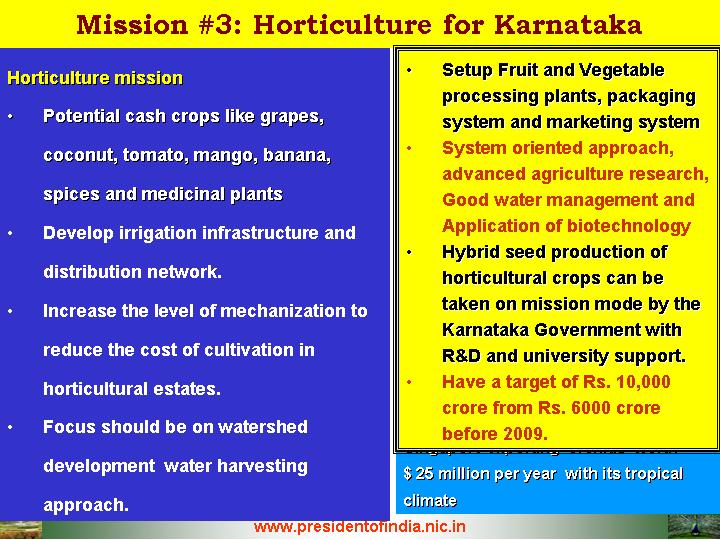

Mission #4: Agro-processing
Karnataka is rich in agricultural produce and horticulture produce. This produce is being directly marketed as raw material. There is a scope for converting this into food products and marketed as ready to eat food in the national and international market where there is a great demand. Also, Udupi and MTR have the necessary skill and competence in making ready to eat food in the state. The Central Food Technology Research Institute (CFTRI), Defence Food Research Lab (DFRL) and the private sector industries can provide the latest technology input for converting the agro and horticulture products into ready to eat food. With this strength Karnataka should become food processing outsourcing destination as in the case of IT. Recently, it has been reported that Indian Currypacks in 10 ltr drums are in great demand in both US and UK. This will give an opportunity for the farmers in the unorganized sector to supply cut vegetables to the food service centers. They also can supply processed meat, sea food, ready to use perishables, processed and semi-processed bakery products. What is needed is facilities for hygienic processing, rugged packaging and guaranteed quality including standardization of the product. If all these factors are fulfilled Karnataka can aspire to export over Rs.50,000 Crores of value added agro-food products in the national and international market. What we need is a mission mode operation for such a venture. The Karnataka and the Indian food are very safe from vast spreading diseases like Avian bird flu and the western world has been looking forward to the import of the Indian delights.
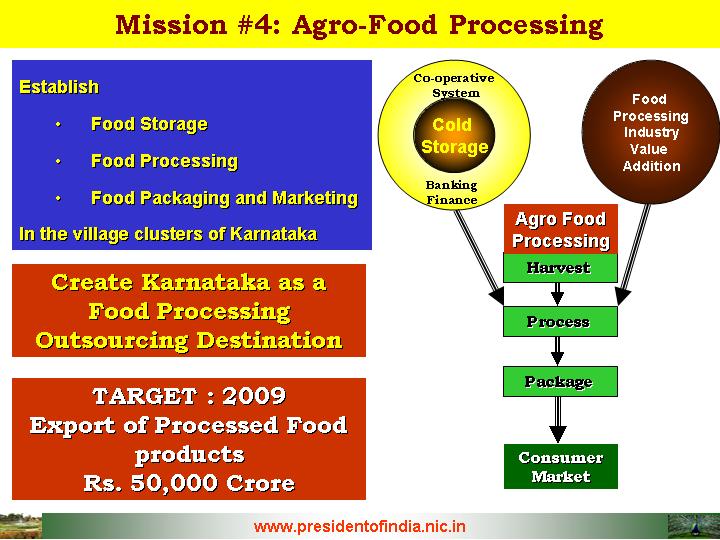

Mission # 5: Water management
Bangalore gets adequate rainfall and there is a need to create water harvesting and waste water recycling facilities in each of the households and, apartments, complexes, government buildings, hotels, hospitals, industrial establishments and institutions, through a comprehensive water harvesting policy for the state.
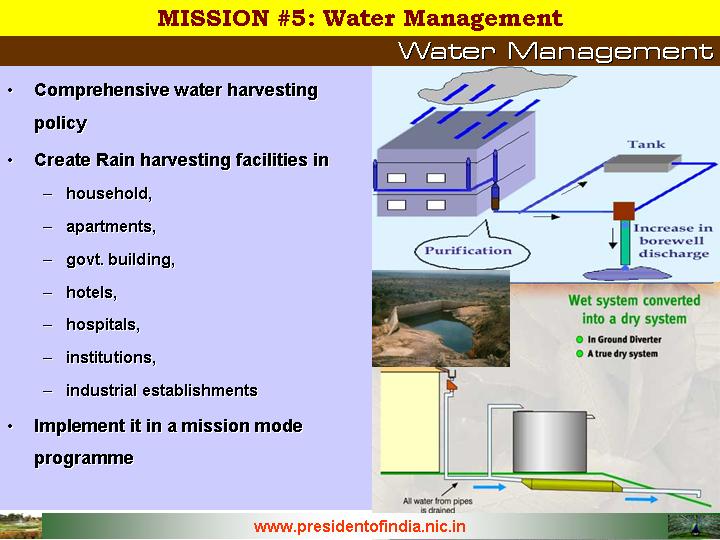
I was in Mizoram a few weeks back. As you know it is a beautiful hill state with forests all around, rivers flowing in the valley and people living in the hill tops. I saw a unique water harvesting technique in every Mizo house. A beautiful large diameter galvanized drum with connectivity and filter for collecting rain water is placed in front of each house. Karnataka has abundance of rain for many months. The state needs a water harvesting policy for storing and meeting the water demands during the lean months, especially in certain low rainfall areas. The State also should pioneer in waste water recycling and reuse.

Mission # 6: Tourism
There are a number of places of interest in Karnataka which will be an attraction for the tourists. The visitor is attracted to Vithala temple in Hampi with the stone chariot and the fifty six musical pillar, Chennakesava temple on the banks of the river Yagachi in Bellore, Mysore Palace, Bidar Fort, Sriranga Pattinam, Bandipur wildlife sanctuary, white water rafting, Kudremukh, Nadhi hills, Hebbe and Jog falls, folk theatre art of Uttara Karnataka, Sri Mookambika temple and many more spiritual wildlife and historical spots. Also there are state-of-the-art hospitals, aeronautical institutions, scientific institutions, ICT and bio-technology institutions. I am delighted to know that many chartered flights land in Bangalore every year.
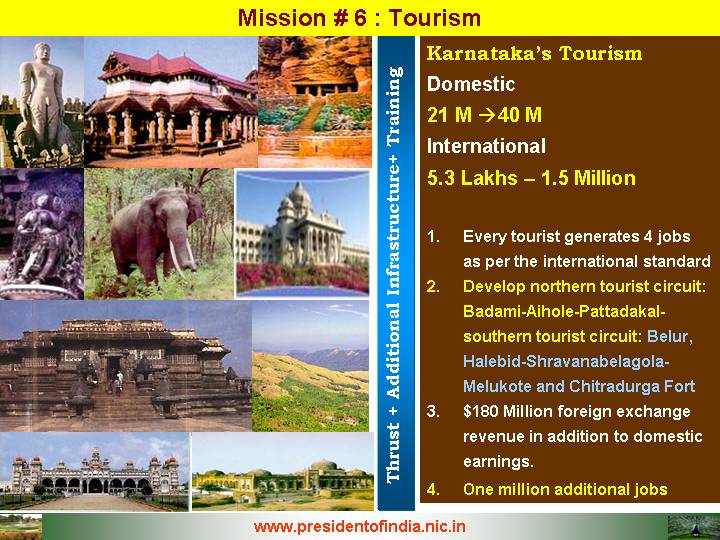
When I am with you today, I am reminded of my visit to Asia, Europe and Africa in the year 2003, particularly I would like to narrate an incident. In Dubai (UAE), I met the Ruler of Dubai. He said that Dubai is planning to increase the tourist arrival by five times. Once this decision was taken I found, that the aviation minister was planning for a new airport and also new types of aircraft needed for attracting the tourists. The surface transport minister was planning a number of additional lanes required in the highways. The works ministry was planning for increase in the hotel accommodation for accommodating the tourists without disappointment. The health ministry had a road map for waste management, additional clean water need. This was the type of integrated response that I found in the whole government to fulfill the national objective. We have to take the message of this experience and plan for the multiple requirements through integrated planning, simultaneously for promoting tourism in our country. Particularly for Karnataka there is a need to plan and execute the necessary tourism infrastructure in an integrated fashion. Also, care must be taken to improve the infrastructure for all the 27 districts so that tourist can visit all the important tourists destinations spread in different parts of Karnataka in a prescribed time frame.
We need people friendly professional tour operators having proficiency in this field. They should have the ability to use modern tools and be able to provide in-depth factual data about various places of interests to the tourists. They should also guide them to avail diversified tourist products such as general, spiritual, and eco-tourism. The tourist operator should also acquire proficiency in different languages such as Telugu, Tamil, Marathi, Konkani, English, Hindi in addition to many foreign languages. This will attract tourists and provide job for the youth of Karnataka.
Karnataka with its unique tourist places of interest can definitely increase the domestic tourist arrival to 40 million from the existing 21million, and foreign tourist arrival from the existing 5.3 lakh to 1.5 million. Every tourist national or international generates at least 4 jobs as per the international experience. This will need development of northern tourist circuit: Badami-Aihole-Pattadakal-southern tourist circuit: Belur, Halebid-Shravanabelagola-Melukote and Chitradurga Fort. This increase in tourist arrival will provide additional employment to large number of Karnataka youth in various sectors of the tourism industry. It will also generate business of over $ 180 Million in foreign exchange in addition to revenue from the domestic tourists. Karnataka's wealth is the ancient architecture, beautiful parks and forest areas. While the tourist inflow will increase in the coming years it is essential to preserve a great heritage of Karnataka including its forest cover by evolving an appropriate environment Policy. This should enable regulation of the increased tourist inflow and continuously improving the environment.

Mission # 7: Preparing Paramedics and technicians with quality Training
India is in the process of improving the healthcare services which will need additional 5 lakh nurses. As per the latest report, worldwide requirement for nurses are estimated to be around one million from now to 2012. Presently, in India about 50,000 nurses qualify every year. There is a need to increase this capacity to 2 lakhs within the next five years in the country. Karnataka has a core competence in nursing, because of its cultural environment. Karnataka can make use of this opportunity and double the intake in Nursing College after augmenting the facilities to meet international requirements. This will enable Karnataka to participate in the mission of providing high quality nurses to work in international institutions and facilitate the government to provide job opportunity to at least 5000 nurses.
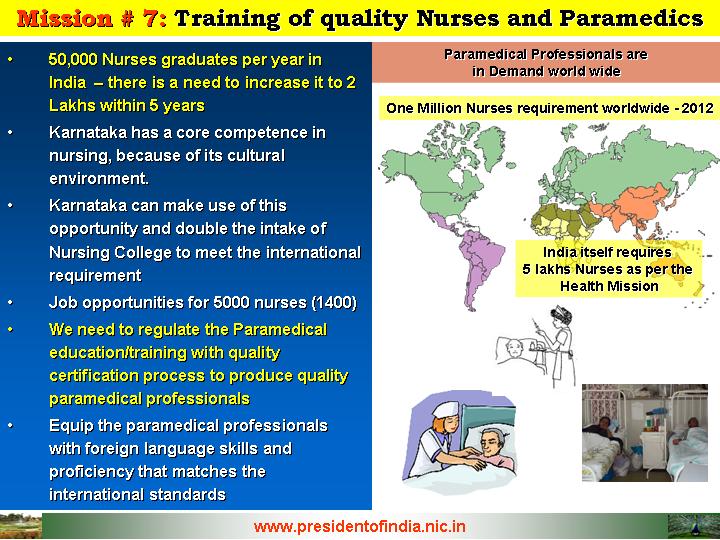
In addition there must be a special drive to equip the nurses with training at various healthcare centers and super speciality environments and equip them with language skills and proficiencies that can match the required international standards. This will be one of the important employment avenues for the compassionate women of Karnataka. The Department of Health in Karnataka should draw up a scheme and create the training facility in collaboration with the Central Government immediately. If clear autonomy is given private sector also step in. In addition there is a need for many other specialized paramedical personnel. Skilled technicians and the para medical assistance are in great demand world over in the healthcare sector. The Tremendous potential exists for educated youth to take up nursing and para-medics as a profession. The generation of quality nurses and skilled technicians can be taken as one of missions for the development of healthcare services and employment generations in Karnataka.

Mission # 8: Creation of industries for Knowledge products
Presently Karnataka is exporting around Rs. 27,600 crore worth of IT, IT Enabled Services and BPO. It provides an employment for around 300,000 persons. The Karnataka Government is committed to improve the infrastructure required for maintaining and improving this level of export in Bangalore. 56% of the total BPO investment in the country is in Bangalore. With the improved infrastructure in Bangalore and in the tier-II cities in Karnataka, it is possible to attract 40% of the BPO and Call centers to the tier-II cities and will be able to reduce the density of the population, transportation and also increase the distributed employment potential across the state uniformly. By doing this, Bangalore can attract more investment in the R&D establishments and industries who are engaged in the development of knowledge products which meets the demands of the worldwide requirements. The routine and information level value additions can be done not from the cities like Bangalore and Mysore, but can be outsourced to the rural areas. This value addition is essential to make the Indian software, hardware and networking industries internationally competitive. Particularly, 600,000 villages needs last mile connectivity through Wireless.
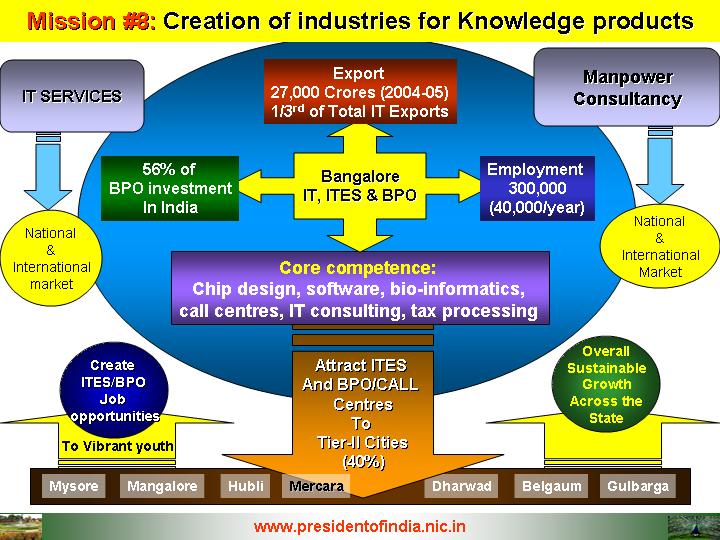
Now the world is moving towards Wi-MAX technology and low cost personal computers and mobile devices, India needs to embark on a mission mode programme to establish the industries which covers the total life cycle of hardware and networking products in collaboration with international partners for design to manufacture and marketing worldwide. Bangalore should take the initiative in this programme. Such a diversification will enable Karnataka to increase the export of IT, ITES,BPO and knowledge products in software-hardware and networking to $20 Billion in the next four years. It will also generate five lakh additional employments for knowledge workers of the state.
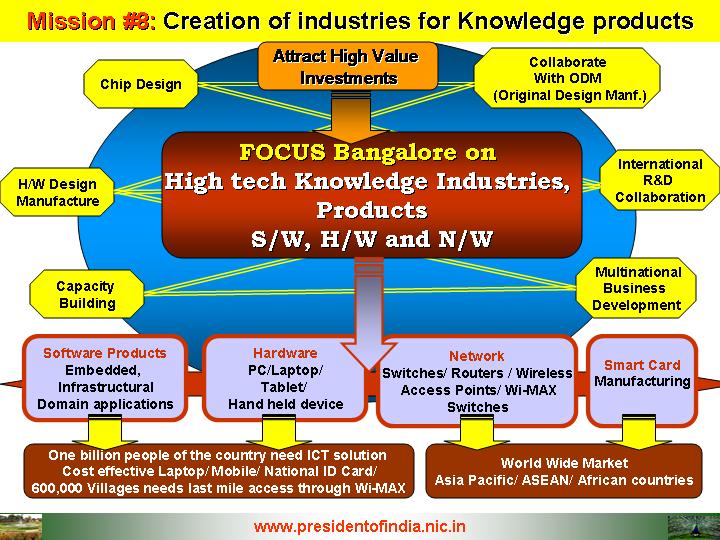
The Hon'ble Members assembled here should debate and work out a strategy to achieve this goal.
Rashtrapati Bhavan has implemented an e-Governance portal for G2G and G2C connectivity forming an e-Governance Grid and Raj Bhavan and Secretariat of Karnataka will shortly get connected to Rashtrapati Bhavan, as in the case of other states and central ministries. The Karnataka State government should embark on a mission of creating a e-governance data centre at the state level and the district level connected through a state wide e-governance grid, enabling a seamless flow of information from Government to Government and government to citizens. This will ensure transparency and fast decision making process.
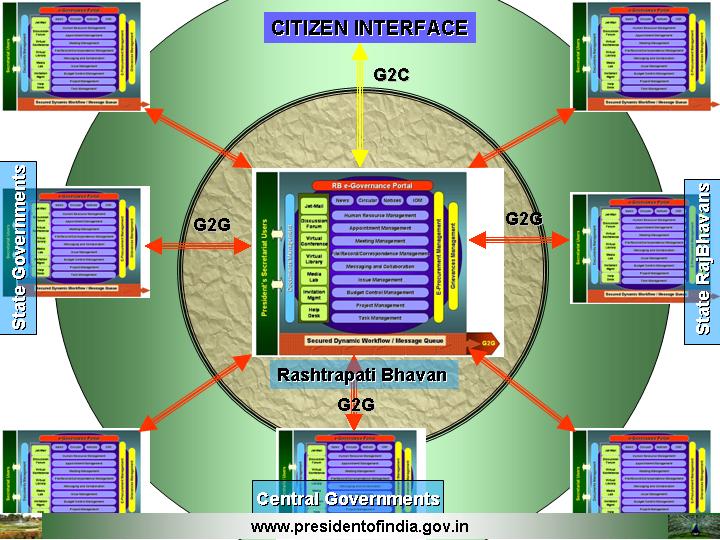

Mission # 9: GIRD Connectivities for sustainable growth
We need to establish high bandwidth 10 Gbps, multiple wavelength, Fiber broadband connectivity - connecting the government, educational and industrial institutions in Bangalore and tier-2 cities and all the district headquarters. While we lay the roads, we can also put in the fiber pipes so that we do not break the roads later for providing service connections. The block level should have at least one gigabits Broadband Fiber connectivity to the district headquarters. Connect the villages to the blocks through Wi-Fi and Wi-Max wireless with at least 10 mbps links. This would enable knowledge connectivity reach the entire state. Can Karnataka take up the challenges of being the first State to have a seamless high bandwidth connection in any part of the State heralding 4G systems?
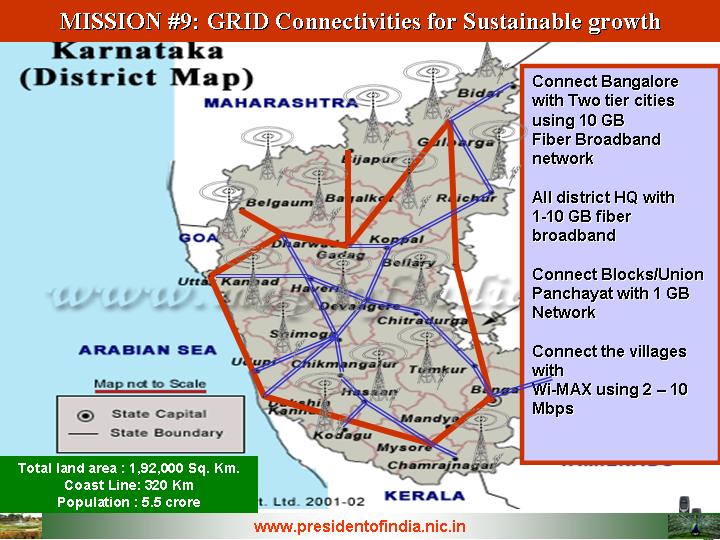
Using the electronic connectivity described above, connect all the government institutions and establishment through e-governance grid, connect all the educational institutions and R&D establishments through knowledge grid, connect the healthcare institutions and government hospitals and create healthcare grid. Ultimately connect all the rural and urban centers and create PURA grid and interconnect this PURA grid to e-governance grid, knowledge grid and healthcare grid thereby facilitating government to citizen access (G2C), access to education through tele-education, access to quality Medicare through tele-medicine in a cost effective manner to citizens of Karnataka. Establish Village Knowledge Centers, Health centers, agri-clinics, agri-business and marketing centers as the delivery mechanisms to the PURA grid enabling the farmers and villagers to maximize their income potential and create a sustainable development model. The entertainment would be the profit earner and would overlay on the knowledge, e-governance, tele-education, tele-medicine grids.
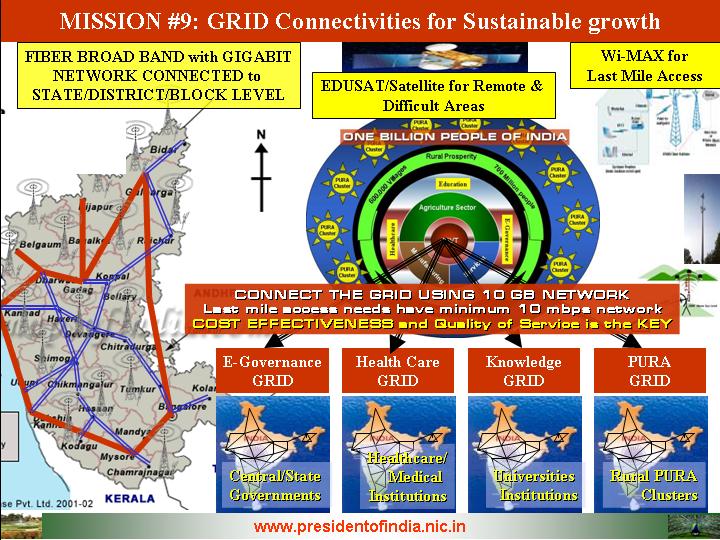

Mission # 10: Establishment of PURA for Rural prosperity
When a states growth is driven by fast changing technologies, one must be cautious about ensuring the participation of every citizen and region of the state with out causing any technology or digital or economic divide. One of the solutions for ensuring the homogenous and integrated development is PURA (Providing Urban Amenities in Rural Areas).

Karnataka has around 28,000 villages spread over twentyseven Districts and has approximately 320 Kms of coast line. On the coastline of PURA we can have seven first order PURA and six second order PURA. In addition to these PURAs Karnataka can have 200 conventional PURAs.
I have discussed with Dr. P.S. Rana, Chairman HUDCO on the development of coastal PURA in Karanataka. I would like to share with you the design of the coastal PURA.
Physical Connectivity: Construction of jetties and small and medium sized boat landing centres on the coast in the interval of 10 to 15 km range. Each of these will have a good link road to the main coastal road. Some times road transportation may be complemented with waterways. Establishment of Community Sheds for repair of nets, storing the nets and related equipments of the fishing community and Boat building and repair small scale industries. In respect of normal PURAs the emphasis will be on providing road connectivity which I have discussed in the infrastructure development.
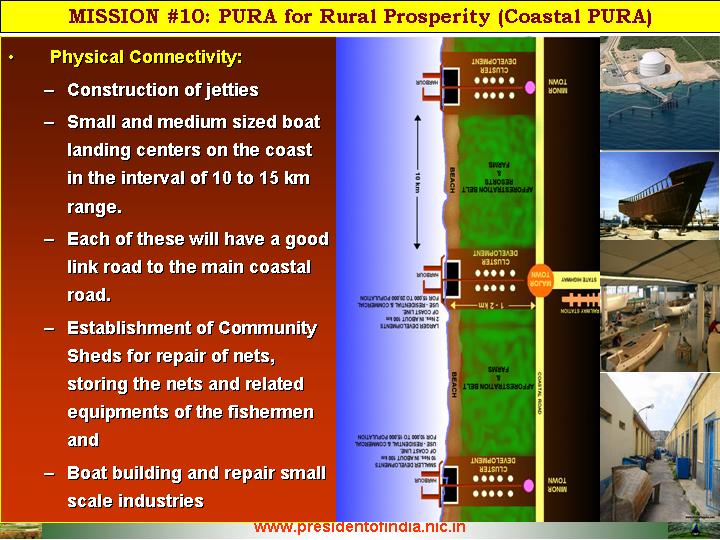
Electronic Connectivity: All the fishing villages on the coastal areas have to be linked with the District Headquarters through the Broadband fibre and wireless connectivities. Fishing community should be provided with broadcasting facilities through Satellite radios and HAMSAT network. Mobile cell phone with GPS facility may be provided for each boat for emergency communication.
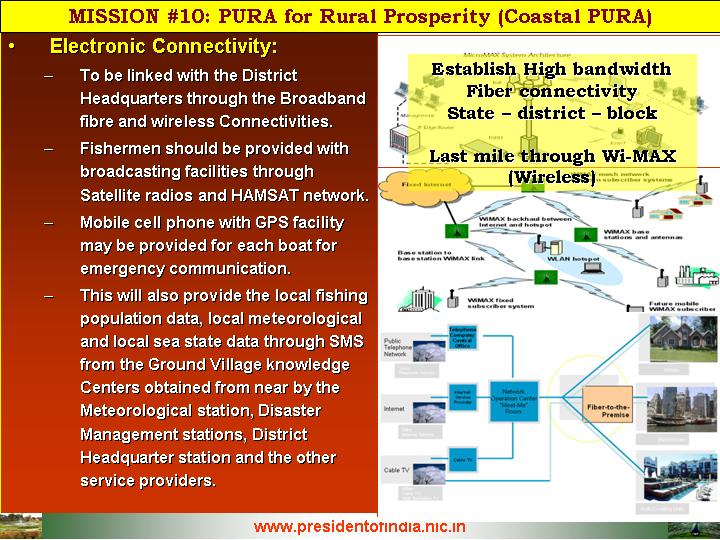
This will also provide the local fishing population data, local meteorological and local sea state data through SMS from the Village knowledge Centres obtained from near by the Meteorological station, Disaster Management stations, District Headquarter station and the other service providers.
Knowledge Connectivity: Government should facilitate the training of fishing community in cost effective safe fishing techniques, application of technology for improving the productivity, storage and preservation systems and cost effective marketing, banking & financing systems through the District Headquarters Studio and the connected village knowledge centers.
It will also provide adequate warning data for the fishing community on the sea to return to home safely.
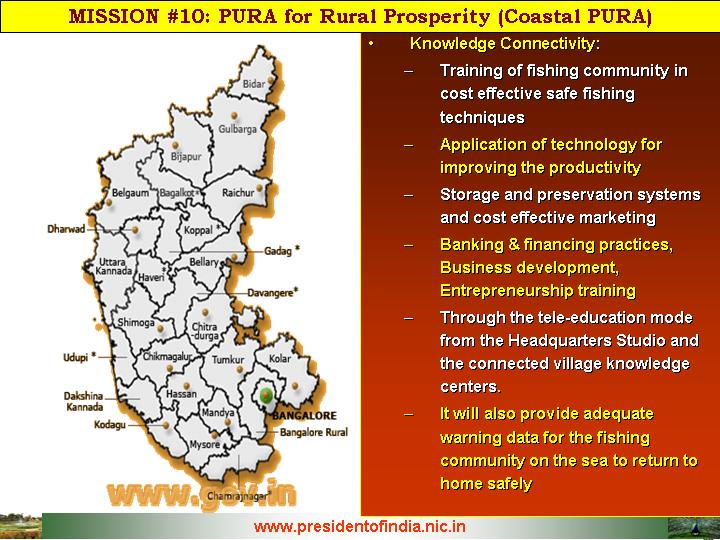
Economic Connectivity: These three connectivities -physical, electronic and knowledge will motivate and enable the local population to create economic centres such as Cold Storage infrastructure, Fish processing and packaging and marketing for realizing the value added price.
This will also provide alternative employment oriented schemes during non-fishing days and for people who are involved in agriculture and other activities. Such economically oriented job creating activities should be the objective of our rural development schemes. With the available coast line I would recommend creation of ten coastal PURAs as discussed above. In addition to the above Karnataka can consider establishment of ten normal PURAs with physical connectivity, electronic connectivity, knowledge connectivity leading to economic connectivity. In respect of physical connectivity, I would recommend creation of inland waterways in addition to multi-lane road systems in areas where rivers are available. This will become an added attraction to the tourists.
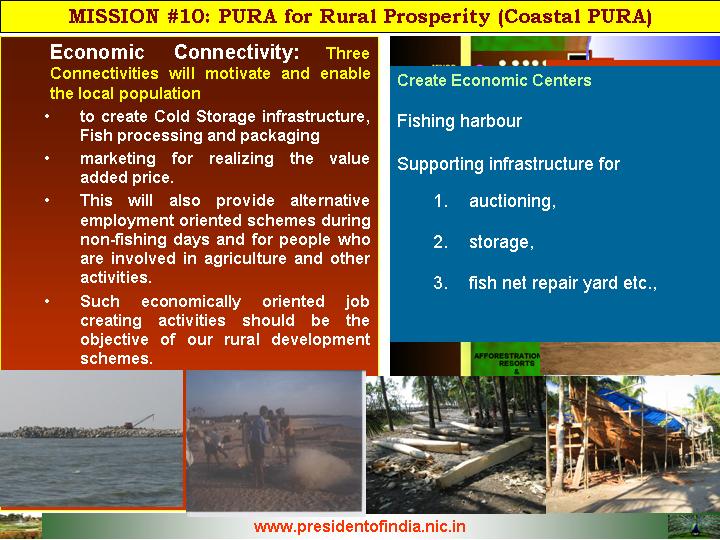

Mission # 11: Development facilitators
Presently, the high revenue ICT industries are concentrated mainly in Bangalore. It is interesting to note that Bangalore occupies one percent of the total area of the state, whereas the present population of Bangalore is 14% of the total population of the state. Similar is the situation at Mysore. There is a need to make the economic activity equitably distributed across the state to ensure homogenous growth taking into consideration the core competence of the regions.
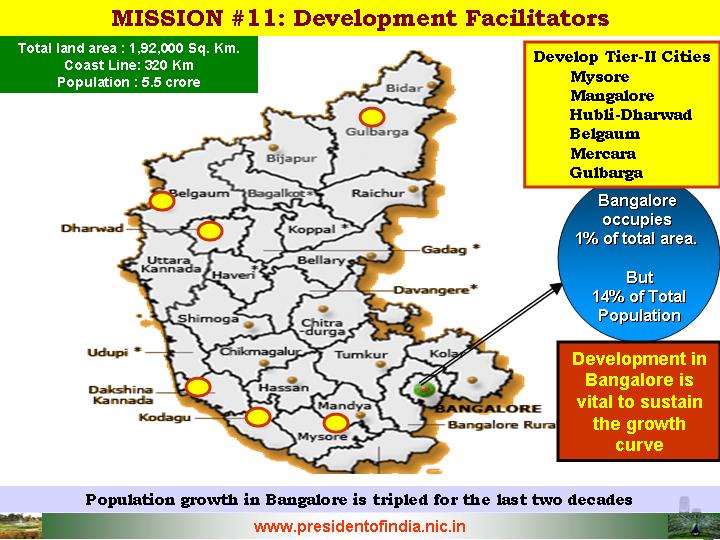
This will be possible only if we develop tier-2 cities in the state around places like Mysore, Mangalore, Hubli, Dharwad, Belgaum, Gulbarga and Mercara. For improving the connectivity and enable the existing industries to disperse and new industries to be created, the first requirement will be to create reliable air connectivity to and between all the tier-2 cities. At the same time there is also a need to make the development facilitators of Bangalore world class. I have seen Bangalore in 1970's, 1980's, 1990's and now. Bangalore's economic growth has far exceeded the growth of the development facilitators. The core attraction of Bangalore being a development facilitator is getting slowly eroded. We should realize that the push and pull effect of the growth of infrastructure is only part of the natural process of development in any dynamic society. We should not get frightened; my mentor Prof. Satish Dhawan of this place has given me great advice, which I will give it to you. Prof. Satish Dhawan told me giving a major project gave me an advice, "Kalam, if you do not have a mission, no problem will occur, but if you do have a mission or task definitely problems of varying magnitudes will crop up. But problems should not become the master of the individuals; individuals should become the master of the problem, defeat it and succeed". For a state which has given the world the first war rocket, pioneer in science and technology revolutions, creating development facilitating environment commensurate with the economic and industrial growth is not an impossible task. You can do it. The whole nation will be with you.
Air Ports: Establish commercial airports at Mysore, Mangalore, Hubli, Dharwad, Belgaum and Gulbarga through BOOT scheme within the next three years. Similarly, Bangalore International Airport has to come into existence by 2008 and should be of world class and should rank with in the first ten best airports in the world.
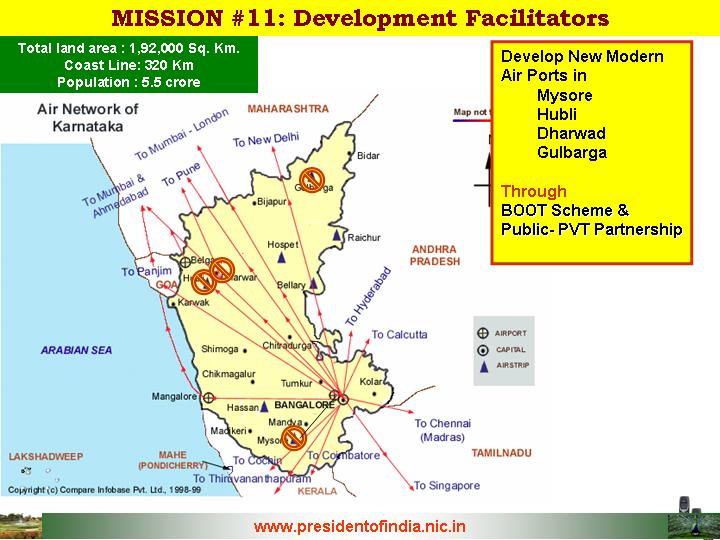
Roads: It is essential to create four to six lane road infrastructure across the state interconnecting Bangalore and all the tier-2 cities with proper linkages to the rest of the country. In the next phase, you can aim to connect all the 270 towns to the tier-2 cities like a hub and spoke model with minimum four lane roads with appropriate flyovers and over bridges. In addition by-pass roads must be created for Bangalore and all the tier-2 cities. Also, there is a need for a ring road for the tier-2 cities for ensuring seamless movement of traffic. Apart from creating this main artery it is essential to create all weather roads in the remaining 33 % of the rural area as part of the PURA development programme through public-private partnership.
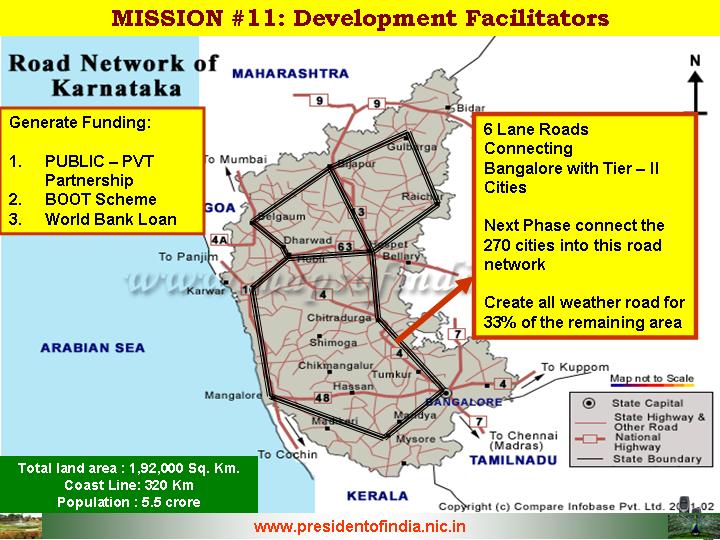
Fast Trains for Tier Two cities: The road capacity in Bangalore has reached a saturation point. This can be eased through alternate possibilities like creation of metro rail system and early commencement of this project is a necessity. Enough care has to be taken while we concretize the state to facilitate development, to ensure that it is not at the cost of any damage to the greenery which makes Bangalore so beautiful. In addition there is a need to create fast railway system on the lines of Shatabti Express between Bangalore and all the tier-2 cities.
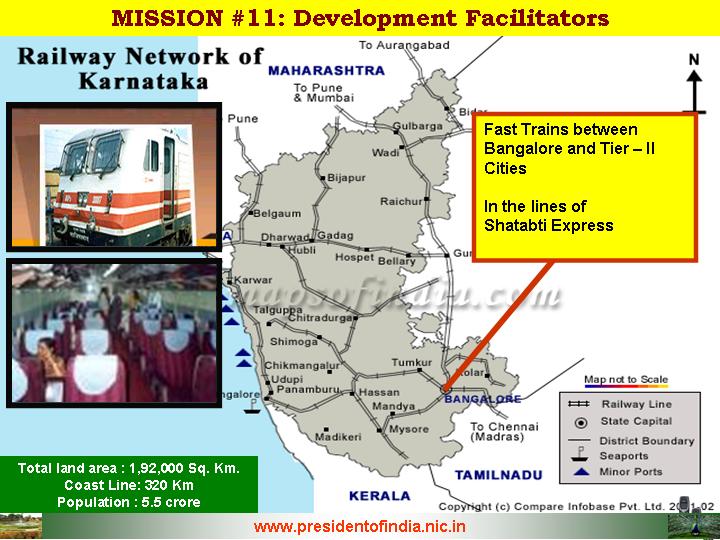

Entrepreneurship
All these nine missions which I have discussed will require generation of large number of entrepreneurs in the State through entrepreneurship programmes. The academic institutions in Karnataka generate about 1.5 lakh graduates per year and the 10th class and 10+2 students will be around 5 lakhs.
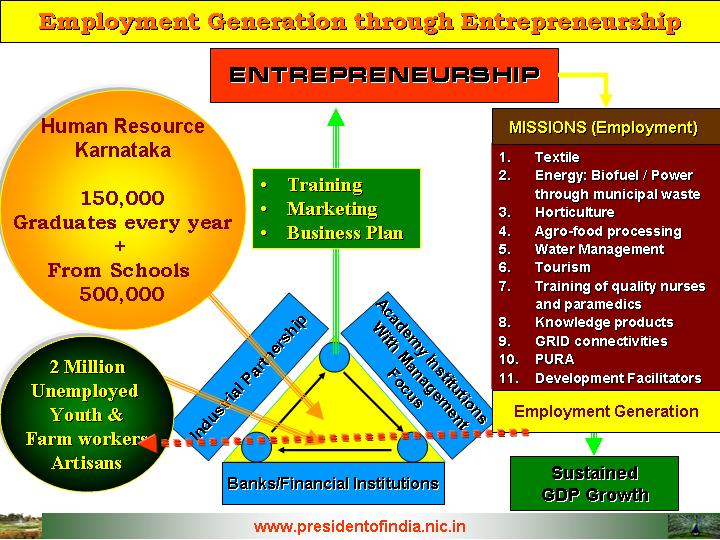
All of them will seek employment in Karnataka. Now the school syllabus and university syllabus have to be integrated with entrepreneurship courses. The students at the end of the course should get a certificate or a diploma. This will enable students who are interested in entrepreneurship to have the confidence that they can start enterprises in agriculture, manufacturing or services especially in the areas of horticulture, tourism, and ancillary industries for aircraft and space system manufacture, automobile components and creation of PURAs. Banks have to be entrepreneur friendly and should give them venture capital and support these young entrepreneurs and their creative ideas. This system will change the situation in Karnataka by generating employment providers rather than employment seekers.
The training in schools and colleges must also be able to incubate and sustain the scientific research temperament of the students and should encourage them in large measures to pursue research career.

Conclusion
The eleven missions suggested for Karnataka may please be discussed in the Karnataka Legislative Assembly and Council for transforming Karnataka as a developed state in the next decade. The outcome from each of the missions will be:
1. Textiles mission will result in export of One Billion dollar worth of products and generate employment for four lakhs direct and four lakhs indirect Infrastructure
2. Bio-fuel mission will generate revenue of Rs.875 Cr and provide employment for 14 lakh youth.
3. Horticulture Mission will result in a revenue of Rs.10,000 Cr with higher employment potential.
4. Agro-processing industry will result in export revenue of Rs.50,000 Crores with employment potential for large number of rural and urban youth.
5. Preparing paramedics and technicians will generate employment for 5000 nurses and 5000 paramedics per year.
6. Tourism mission will generate at least 1 million additional jobs to service the international and domestic tourists and $180 million in foreign exchange.
7. Creation of Industries for knowledge products will result in export of $20 Bn worth of products and services and generate employment for 5 lakh knowledge workers.
8. Establishment of PURA (13 coastal and 200 conventional) will lead to higher employment potential in the rural areas and better standard of living for the 67% of rural population.
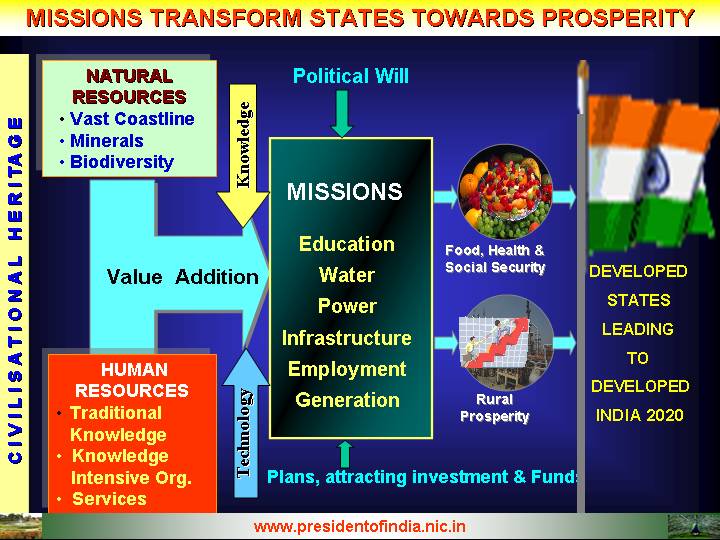
Karnataka is a safe and peaceful state in the Indian map. This atmosphere has to be complimented with creative tasks and missions, to empower the people of Karnataka for economic prosperity. The combination of peace and economic prosperity is indeed the dream of all the youth of the State. Enhancing the prosperity of Karnataka consistent with our civilizational heritage has to be the mission of the members of the Karnataka Legislative Assembly. You have all the potential for planning and accomplishing all the missions. We need large number of creative leaders. Who are these creative leaders: Creative leadership means exercising the vision to change the traditional role from the commander to the coach, manager to mentor, from director to delegator and from one who demands respect to one who facilitates self-respect. With such a leadership, courage, hard work and God's grace, I am sure that the Members of this Legislative Assembly and the Council will be able to transform Karnataka into a more prosperous, happy, peaceful and secure State. My best wishes for you in this mission.
May God bless you.
<<Back
|
|